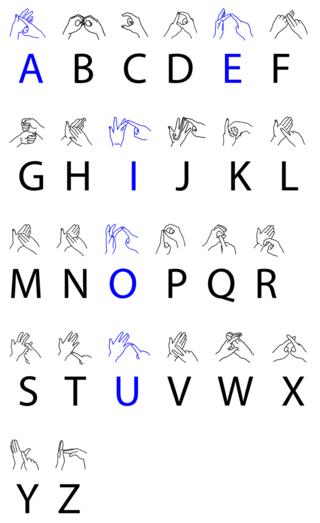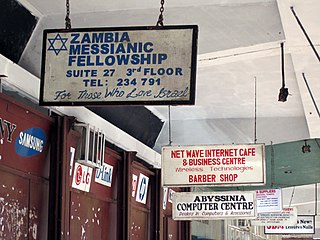Related Research Articles

Sign languages are languages that use the visual-manual modality to convey meaning, instead of spoken words. Sign languages are expressed through manual articulation in combination with non-manual markers. Sign languages are full-fledged natural languages with their own grammar and lexicon. Sign languages are not universal and are usually not mutually intelligible, although there are also similarities among different sign languages.
International Sign (IS) is a pidgin sign language which is used in a variety of different contexts, particularly at international meetings such as the World Federation of the Deaf (WFD) congress, in some European Union settings, and at some UN conferences, at events such as the Deaflympics, the Miss & Mister Deaf World, and Eurovision, and informally when travelling and socialising.

British Sign Language (BSL) is a sign language used in the United Kingdom (UK), and is the first or preferred language among the Deaf community in the UK. Based on the percentage of people who reported 'using British Sign Language at home' on the 2011 Scottish Census, the British Deaf Association estimates there are 151,000 BSL users in the UK, of which 87,000 are Deaf. By contrast, in the 2011 England and Wales Census 15,000 people living in England and Wales reported themselves using BSL as their main language. People who are not deaf may also use BSL, as hearing relatives of deaf people, sign language interpreters or as a result of other contact with the British Deaf community. The language makes use of space and involves movement of the hands, body, face, and head.
Auslan is the majority sign language of the Australian Deaf community. The term Auslan is a portmanteau of "Australian Sign Language", coined by Trevor Johnston in the 1980s, although the language itself is much older. Auslan is related to British Sign Language (BSL) and New Zealand Sign Language (NZSL); the three have descended from the same parent language, and together comprise the BANZSL language family. Auslan has also been influenced by Irish Sign Language (ISL) and more recently has borrowed signs from American Sign Language (ASL).
Interpreting is a translational activity in which one produces a first and final target-language output on the basis of a one-time exposure to an expression in a source language.
New Zealand Sign Language or NZSL is the main language of the deaf community in New Zealand. It became an official language of New Zealand in April 2006 under the New Zealand Sign Language Act 2006. The purpose of the act was to create rights and obligations in the use of NZSL throughout the legal system and to ensure that the Deaf community had the same access to government information and services as everybody else. According to the 2013 Census, over 20,000 New Zealanders know NZSL.

German Sign Language or Deutsche Gebärdensprache (DGS), is the sign language of the deaf community in Germany, Luxembourg and in the German-speaking community of Belgium. It is unclear how many use German Sign Language as their main language; Gallaudet University estimated 50,000 as of 1986. The language has evolved through use in deaf communities over hundreds of years.
Japanese Sign Language, also known by the acronym JSL, is the dominant sign language in Japan and is a complete natural language, distinct from but influenced by the spoken Japanese language.

South African Sign Language is the primary sign language used by deaf people in South Africa. The South African government added a National Language Unit for South African Sign Language in 2001. SASL is not the only manual language used in South Africa, but it is the language that is being promoted as the language to be used by the Deaf in South Africa, although Deaf peoples in South Africa historically do not form a single group.
Indo-Pakistani Sign Language (IPSL) is the predominant sign language in the subcontinent of South Asia, used by at least 15 million deaf signers. As with many sign languages, it is difficult to estimate numbers with any certainty, as the Census of India does not list sign languages and most studies have focused on the north and urban areas. As of 2021, it is the most used sign language in the world, and Ethnologue ranks it as the 151st most "spoken" language in the world.

Mexican Sign Language, is a natural language that serves as the predominant language of the Deaf community in Mexico. LSM is a complete and organized visual language, which is expressed with the hands, face, and body, with its own distinct history, community, and culture. There are several dialects based on regional variation and LSM may be learned as a second language by hearing and Deaf signers. LSM is closely related to French Sign Language (LSF) and American Sign Language (ASL), although it is mutually unintelligible.
Manually coded languages (MCLs) are a family of gestural communication methods which include gestural spelling as well as constructed languages which directly interpolate the grammar and syntax of oral languages in a gestural-visual form—that is, signed versions of oral languages. Unlike the sign languages that have evolved naturally in deaf communities, these manual codes are the conscious invention of deaf and hearing educators, and as such lack the distinct spatial structures present in native deaf sign languages. MCLs mostly follow the grammar of the oral language—or, more precisely, of the written form of the oral language that they interpolate. They have been mainly used in deaf education in an effort to "represent English on the hands" and by sign language interpreters in K-12 schools, although they have had some influence on deaf sign languages where their implementation was widespread.
Kenyan Sign Language is a sign language used by the deaf community in Kenya and Somalia. It is used by over half of Kenya's estimated 600,000 deaf population. There are some dialect differences between Kisumu, Mombasa and Somalia.
Polish Sign Language is the language of the Deaf community in Poland. Polish Sign Language uses a one-handed manual alphabet of Old French Sign Language and therefore appears to be related to French Sign Language. It may also have common features with Russian and German sign language, which is related to the history of Poland during the partitions, when Russification and Germanization significantly influenced the Polish language, and may also have borrowings from the sign language used in the Austrian partition. Its lexicon and grammar are distinct from the Polish language, although there is a manually coded version of Polish known as System Językowo-Migowy, which is often used by interpreters on television and by teachers in schools.

Zambia has several major indigenous languages, all members of the Bantu family, as well as Khwedam, Zambian Sign Language, several immigrant languages and the pidgins Settla and Fanagalo. English is the official language and the major language of business and education.
Italian Sign Language or LIS is the visual language used by deaf people in Italy. Deep analysis of it began in the 1980s, along the lines of William Stokoe's research on American Sign Language in the 1960s. Until the beginning of the 21st century, most studies of Italian Sign Language dealt with its phonology and vocabulary. According to the European Union for the Deaf, the majority of the 60,000–90,000 Deaf people in Italy use LIS.

Swedish Sign Language is the sign language used in Sweden. It is recognized by the Swedish government as the country's official sign language, and hearing parents of deaf individuals are entitled to access state-sponsored classes that facilitate their learning of SSL. There are fewer than 10,000 speakers, making the language officially endangered.
The deaf sign language of the nations of the former Yugoslavia, known variously as Croatian Sign Language, Kosovar Sign Language, Serbian Sign Language, Bosnian Sign Language, Macedonian Sign Language, Slovenian Sign Language, or Yugoslav Sign Language (YSL), got its start when children were sent to schools for the deaf in Austro-Hungary in the early 19th century. The first two local schools opened in 1840 in Slovenia and in 1885 in Croatia.
Russian Sign Language (RSL) is the sign language used by the Deaf community in Russia and possibly Ukraine, Belarus and Tajikistan. It belongs to the French Sign Language family.
In South Africa, manually coded language is used in education, as a bridge between South African Sign Language (SASL) and the eleven official oral languages of the country. These codes apply the signs of SASL to the grammar of the oral languages, resulting in Signed English, Signed Afrikaans, Signed Xhosa, Signed Zulu, etc. They are not a natural form of communication among deaf people.
References
- ↑ Zambian Sign Language at Ethnologue (18th ed., 2015) (subscription required)